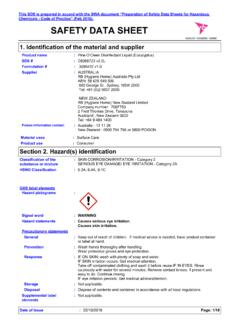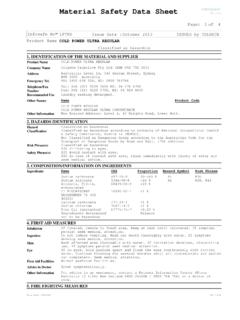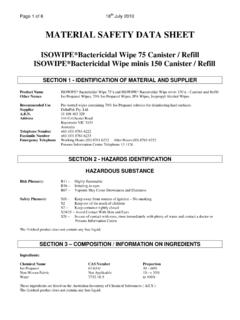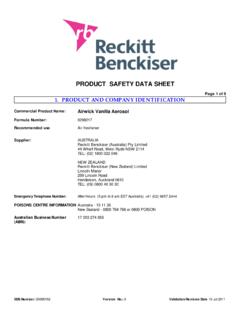Transcription of SAFETY DATA SHEET - rb-msds.com.au
1 Harpic Active Fresh Liquid1. Identification of the material and supplierSAFETY data SHEETP roduct nameHarpic Active Fresh Liquid:SDS no.:NamesMaterial usesToilet bowl cleaner:30961 - SD AU - 13 11 26 New Zealand - 0800 764 766 or 0800 POISON Poison Information contact::Formulation #:0289302 ; 0289304 ; 0289303 ; 0373120 ; 0289301 Supplier:AUSTRALIAR eckitt Benckiser (Australia) Pty LimitedABN: 17 003 274 655680 George Street, Sydney NSW 2000 Tel: +61 (0)2 9857 2000 NEW ZEALANDR eckitt Benckiser (New Zealand) Limited2 Fred Thomas Drive, Takapuna,Auckland, New Zealand 0622 Tel: +64 9 484 1400 Consumer:Product useThis SDS is prepared in accord with the SWA document Preparation of SAFETY data Sheets for Hazardous Chemicals - Code of Practice (Feb 2016).
2 Section 2. Hazard(s) identificationNot classifiedClassification of the substance or mixture:Signal word:No signal statements:No known significant effects or critical statementsPrevention:Not :Not :Not :Not hazards which do not result in classification:None label elementsGeneral:Read label before use. Keep out of reach of children. If medical advice is needed,have product container or label at label elements:Not of issuePage: 1/815/12/2016:30961 - SD AU 3. Composition and ingredient information Other Non-hazardous ingredients to 100%Substance/mixture:Occupational exposure limits, if available, are listed in Section out mouth with water. Remove victim to fresh air and keep at rest in a position comfortable for breathing.
3 If material has been swallowed and the exposed person is conscious, give small quantities of water to drink. Do not induce vomiting unless directed to do so by medical personnel. Get medical attention if symptoms flush eyes with plenty of water, occasionally lifting the upper and lower eyelids. Check for and remove any contact lenses. Get medical attention if irritation contaminated skin with plenty of water. Remove contaminated clothing and shoes. Get medical attention if symptoms victim to fresh air and keep at rest in a position comfortable for medical attention if symptoms 4. First aid measuresEye contactSkin contactInhalationIngestion::::Protection of first-aiders:No action shall be taken involving any personal risk or without suitable to physician:Treat symptomatically.
4 Contact poison treatment specialist immediately if large quantities have been ingested or of necessary first aid measuresSpecific treatments:No specific important symptoms/effects, acute and delayedInhalation:No known significant effects or critical known significant effects or critical hazards.:IngestionSkin contact:No known significant effects or critical known significant effects or critical hazards.:Eye contactOver-exposure signs/symptomsSkin contactIngestionInhalationNo specific specific specific data .:::Eye contact:No specific acute health effectsSee toxicological information (Section 11)Indication of immediate medical attention and special treatment needed, if necessarySection 5.
5 Firefighting measuresHazardous thermal decomposition productsSpecific hazards arising from the chemicalNo specific a fire or if heated, a pressure increase will occur and the container may an extinguishing agent suitable for the surrounding media::None extinguishing media:Unsuitable extinguishing media:Date of issuePage: 2/815/12/2016:30961 - SD AU 5. Firefighting measuresPromptly isolate the scene by removing all persons from the vicinity of the incident if there is a fire. No action shall be taken involving any personal risk or without suitable should wear appropriate protective equipment and self-contained breathing apparatus (SCBA) with a full face-piece operated in positive pressure protective equipment for fire-fighters:Special protective actions for fire-fighters:Section 6.
6 Accidental release measuresEnvironmental precautionsPersonal precautions, protective equipment and emergency proceduresStop leak if without risk. Move containers from spill area. Prevent entry into sewers,water courses, basements or confined areas. Wash spillages into an effluent treatment plant or proceed as follows. Contain and collect spillage with non-combustible, absorbent material sand, earth, vermiculite or diatomaceous earth and place in container for disposal according to local regulations (see Section 13).Dispose of via a licensed waste disposal contractor. Note: see Section 1 for emergency contact information and Section 13 for waste disposal.::No action shall be taken involving any personal risk or without suitable surrounding areas.
7 Keep unnecessary and unprotected personnel from entering. Do not touch or walk through spilt material . Put on appropriate personal protective dispersal of spilt material and runoff and contact with soil, waterways, drains and sewers. Inform the relevant authorities if the product has caused environmental pollution (sewers, waterways, soil or air).Large spill:Stop leak if without risk. Move containers from spill area. Dilute with water and mop up if water-soluble. Alternatively, or if water-insoluble, absorb with an inert dry material and place in an appropriate waste disposal container. Dispose of via a licensed waste disposal spill:Methods and material for containment and cleaning upFor non-emergency personnelFor emergency responders:If specialised clothing is required to deal with the spillage, take note of any information in Section 8 on suitable and unsuitable materials.
8 See also the information in "For non-emergency personnel".See Section 1 for emergency contact Section 8 for information on appropriate personal protective Section 13 for additional waste treatment 7. Handling and storageAdvice on general occupational hygieneConditions for safe storage,including any incompatibilitiesEating, drinking and smoking should be prohibited in areas where this material is handled, stored and processed. Workers should wash hands and face before eating, drinking and smoking. Remove contaminated clothing and protective equipment before entering eating areas. See also Section 8 for additional information on hygiene in accordance with local regulations.
9 Store in original container protected from direct sunlight in a dry, cool and well-ventilated area, away from incompatible materials (see Section 10) and food and drink. Keep container tightly closed and sealed until ready for use. Containers that have been opened must be carefully resealed and kept upright to prevent leakage. Do not store in unlabelled appropriate containment to avoid environmental contamination.::Protective measuresPut on appropriate personal protective equipment (see Section 8).:Precautions for safe handlingDate of issuePage: 3/815/12/2016:30961 - SD AU 8. Exposure controls and personal protectionHand protectionBased on the hazard and potential for exposure, select a respirator that meets the appropriate standard or certification.
10 Respirators must be used according to a respiratory protection program to ensure proper fitting, training, and other important aspects of , impervious gloves complying with an approved standard should be worn at all times when handling chemical products if a risk assessment indicates this is eyewear complying with an approved standard should be used when a risk assessment indicates this is necessary to avoid exposure to liquid splashes, mists,gases or dusts. If contact is possible, the following protection should be worn,unless the assessment indicates a higher degree of protection: SAFETY glasses with protectionRespiratory protection:::Body protectionPersonal protective equipment for the body should be selected based on the task being performed and the risks involved and should be approved by a specialist before handling this product.










